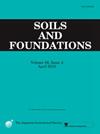砂堆试验及边坡破坏的统计分析,破坏形态及频率分布
IF 3.3
2区 工程技术
Q2 ENGINEERING, GEOLOGICAL
引用次数: 0
摘要
自然斜坡是在没有人为干预的情况下形成的,容易受到地震和强降雨等事件的破坏。由于地震运动方向、地面非均质性和降雨入渗不稳定等因素的影响,这些破坏的特征(包括滑面形状和崩塌幅度)变化很大。尽管进行了大量的试验研究,但对边坡破坏现象的概率性质仍知之甚少。本研究采用砂桩模型对边坡破坏及其震级进行了实验分析和统计分析。砂堆模型涉及到逐渐向桩上加砂,并反复观察其倒塌。实验采用8号硅砂(细砂)在直径为5 cm ~ 12 cm的底板上进行。形状变化是用深度相机捕捉到的。结果表明,砂堆的几何变化主要发生在砂堆的顶端,这是最初破坏稳定的地方。砂桩顶端的亚稳坡角导致边坡失稳的迟滞行为。发生频率和破坏质量偏离正态分布,较小的震级发生频率较高,较大的震级发生频率急剧下降。这种模式反映了在地震中观察到的频率-震级关系,研究结果与古腾堡-里希特定律一致,证实了这一假设。本研究获得的b值在文献中可用的滑坡频率大小统计范围内。本文章由计算机程序翻译,如有差异,请以英文原文为准。
Sandpile experiments and statistical analysis for slope failure, failure shape, and frequency distribution
Natural slopes, which occur without human intervention, are susceptible to failure triggered by events such as earthquakes and heavy rainfall. The characteristics of these failures, including the shape of the slip surface and the magnitude of collapse, vary significantly due to factors like the direction of seismic motion, ground heterogeneity, and unsteady rainfall infiltration. Despite numerous experimental studies, the probabilistic nature of slope failure phenomena remains insufficiently understood. This study employs experimental and statistical analysis using the sandpile model to elucidate slope failures and their magnitudes. The sandpile model involves gradually adding sand to a pile and repeatedly observing its collapse. Experiments were conducted using silica sand No. 8 (fine sand) on base plates with diameters ranging from 5 cm to 12 cm. Shape variations were captured using a depth camera. The results indicate significant geometric changes predominantly at the apex of the sandpile, where the initial breach of stability occurs. The metastable slope angle at the apex of the sandpile induces hysteresis behavior in slope failure. The frequency of occurrence and failure mass deviates from a normal distribution, with smaller magnitudes occurring more frequently and a sharp decrease in frequency for larger magnitudes. This pattern mirrors the frequency-magnitude relationship observed in earthquakes, with the study’s results aligning with the Gutenberg-Richter law, confirming the hypothesis. The b-value obtained from this study falls within the range of frequency-size landslide statistics available in the literature.
求助全文
通过发布文献求助,成功后即可免费获取论文全文。
去求助
来源期刊

Soils and Foundations
工程技术-地球科学综合
CiteScore
6.40
自引率
8.10%
发文量
99
审稿时长
5 months
期刊介绍:
Soils and Foundations is one of the leading journals in the field of soil mechanics and geotechnical engineering. It is the official journal of the Japanese Geotechnical Society (JGS)., The journal publishes a variety of original research paper, technical reports, technical notes, as well as the state-of-the-art reports upon invitation by the Editor, in the fields of soil and rock mechanics, geotechnical engineering, and environmental geotechnics. Since the publication of Volume 1, No.1 issue in June 1960, Soils and Foundations will celebrate the 60th anniversary in the year of 2020.
Soils and Foundations welcomes theoretical as well as practical work associated with the aforementioned field(s). Case studies that describe the original and interdisciplinary work applicable to geotechnical engineering are particularly encouraged. Discussions to each of the published articles are also welcomed in order to provide an avenue in which opinions of peers may be fed back or exchanged. In providing latest expertise on a specific topic, one issue out of six per year on average was allocated to include selected papers from the International Symposia which were held in Japan as well as overseas.
 求助内容:
求助内容: 应助结果提醒方式:
应助结果提醒方式:


